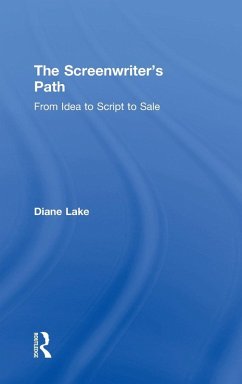- Gebundenes Buch
- Merkliste
- Auf die Merkliste
- Bewerten Bewerten
- Teilen
- Produkt teilen
- Produkterinnerung
- Produkterinnerung
The Screenwriter's Path takes a comprehensive approach to learning how to write a screenplay-allowing the writer to use it as both a reference and a guide in constructing a script. A tenured professor of screenwriting at Emerson College in Boston, author Diane Lake has 20 years' experience writing screenplays for major studios and was a co-writer of the Academy-award winning film Frida. The book sets out a unique approach to story structure and characterization that takes writers, step by step, to a completed screenplay, and it is full of practical advice on what to do with the finished script…mehr
Andere Kunden interessierten sich auch für
![The Screenwriter's Path The Screenwriter's Path]() Diane LakeThe Screenwriter's Path54,99 €
Diane LakeThe Screenwriter's Path54,99 €![Path of the Panther Path of the Panther]() Carlton WardPath of the Panther43,99 €
Carlton WardPath of the Panther43,99 €![Bangkok: Colors of the Beaten Path Bangkok: Colors of the Beaten Path]() Rob BentonBangkok: Colors of the Beaten Path48,99 €
Rob BentonBangkok: Colors of the Beaten Path48,99 €![The Path to Buddha The Path to Buddha]() Robert ThurmanThe Path to Buddha29,99 €
Robert ThurmanThe Path to Buddha29,99 €![Mike Slack: The Transverse Path Mike Slack: The Transverse Path]() Mike Slack: The Transverse Path36,99 €
Mike Slack: The Transverse Path36,99 €![Your Path to Inspiration Your Path to Inspiration]() Kira HarlamorYour Path to Inspiration22,99 €
Kira HarlamorYour Path to Inspiration22,99 €![On the Path of Marigolds On the Path of Marigolds]() Ann MurdyOn the Path of Marigolds38,99 €
Ann MurdyOn the Path of Marigolds38,99 €-
-
-
The Screenwriter's Path takes a comprehensive approach to learning how to write a screenplay-allowing the writer to use it as both a reference and a guide in constructing a script. A tenured professor of screenwriting at Emerson College in Boston, author Diane Lake has 20 years' experience writing screenplays for major studios and was a co-writer of the Academy-award winning film Frida. The book sets out a unique approach to story structure and characterization that takes writers, step by step, to a completed screenplay, and it is full of practical advice on what to do with the finished script to get it seen by the right people. By demystifying the process of writing a screenplay, Lake empowers any writer to bring their vision to the screen.
Hinweis: Dieser Artikel kann nur an eine deutsche Lieferadresse ausgeliefert werden.
Hinweis: Dieser Artikel kann nur an eine deutsche Lieferadresse ausgeliefert werden.
Produktdetails
- Produktdetails
- Verlag: Routledge
- Seitenzahl: 214
- Erscheinungstermin: 11. Oktober 2016
- Englisch
- Abmessung: 235mm x 157mm x 16mm
- Gewicht: 468g
- ISBN-13: 9781138649590
- ISBN-10: 1138649597
- Artikelnr.: 44893951
- Herstellerkennzeichnung
- Libri GmbH
- Europaallee 1
- 36244 Bad Hersfeld
- gpsr@libri.de
- Verlag: Routledge
- Seitenzahl: 214
- Erscheinungstermin: 11. Oktober 2016
- Englisch
- Abmessung: 235mm x 157mm x 16mm
- Gewicht: 468g
- ISBN-13: 9781138649590
- ISBN-10: 1138649597
- Artikelnr.: 44893951
- Herstellerkennzeichnung
- Libri GmbH
- Europaallee 1
- 36244 Bad Hersfeld
- gpsr@libri.de
Diane Lake is an Associate Professor of screenwriting at Emerson College and is a regular speaker at industry conferences. Her film Frida won the American Film Institute's Film of the Year and was nominated for six Academy Awards in 2003, winning two. She has been commissioned to write films for Columbia, Disney, Miramax, and Paramount, and has written a mini-series for NBC, created a half-hour series for ABC, and worked with numerous independent producers, actors, and directors. Diane has been a member of the Writers Guild of America (WGA) for over 20 years, where she has also served as an arbiter to determine film credits. Visit Diane's website at www.DianeLake.com or to schedule Diane for a speaking engagement, please email MichaelGriffin@ScreenwritersPath.com.
TABLE OF CONTENTS FADE IN PART ONE - Taking the First Steps: What you Need to Know to Write a Screenplay Chapter 1: ORIGINAL OR ADAPTED: WHICH ARE YOU WRITING?
Original Screenplays-What You Probably Want to Write
Adapted Screenplays-What You Should Really Think About Writing
Public Domain: Stories Free for the Telling
Published Stories: Contacting Authors and Acquiring Options
Sample Option Document
Whichever You Choose, a Story is a Story is a Story
Chapter One Exercises Chapter 2: CONCEPT
The Big Idea
The Logline
The Premise
Chapter Two Exercises Chapter 3: GENRE
What Kind of Movie is this, Anyway?
Understanding the 'Rules' of the Top 7 Genres in Film Today - Comedy - Romantic Comedy - Action - Thriller - Horror - Fantasy/Sci-Fi - Drama
Breaking the 'Rules' of the Top 7 Genres in Film Today
Chapter Three Exercises Chapter 4: CHARACTER
Whose Story Do You Want to Tell?
Getting to the Heart of Your Main Character
Five Character Questions - Who is this Person and What Does He/She Want? Need? - What is His/Her Inner Life? - Why Should I Care About Him/Her? - What was His/Her Life Like Before the Story Starts? - What Does He/She Sound Like?
Supporting Characters-Please, No Stock Types - Distinctiveness - Variety - Depth
Chapter Four Exercises Chapter 5: CHARACTER/STRUCTURE
Let's Talk Arcs
Why Character and Structure aren't Mutually Exclusive
Using Subplots - a Major Crossroads for Character and Structure
What if the Journey of Your Main Character Mirrors the Trajectory of the Film?
How Understanding this Symbiotic Relationship Can Take You to a Higher Level of Storytelling
Chapter Five Exercises Chapter 6: STRUCTURE
Obligatory Thanks to the Greek Guy: How Aristotle Made it All Clear
Act I: Setting Up Your Story and Main Character's Journey - The Tyranny of Page One - Writing a Killer First 10 Pages - Ending the Act with a Bang-Up Finish
Act II: Taking Your Main Character on a Wild Ride
Act III: Somehow Making the Impossible Possible-Bringing it All Together
The 7 Steps 1-Catalyst 2-Big Event 3-Major Complication 4-2nd Major Complication 5-All is Lost 6-Can it Be?! 7-Resolution
Page Numbers: Why Nearly All Scripts are Around 100 Pages - Seriously? I'm Supposed to Follow Some Cookie-Cutter Formula?! - Why It Works: The Discipline of Storytelling Construction - Going Your Own Way: When to Break Ranks with the 7 Steps
Pacing and How to Feel It - What Makes a Story Move - Writing Action-More Words Means More Care
Deviating From the Norm: Nonlinear Structure and the Anti-Narrative Film
Chapter Six Exercises Chapter 7: DIALOGUE
Writing Good Dialogue: Can it be Taught?
Working Like Crazy to be Conversational
Why Less is Always More
Saying What's Not Being Said Says it All
Chapter Seven Exercises Chapter 8: WRITING THE ADAPTATION
Why Adaptations are Favored Over Originals in the Industry Today
Public Domain: Stories Free for the Telling
Published Stories: Contacting Authors and Acquiring Options
How to Know What Makes a Good Story for Adaptation
Breaking Down a 400 Page Novel into a 100 Page Screenplay: A Daunting Task
Sample Option and Shopping Documents
Chapter Eight Exercises Chapter 9: WHEN TO USE YOUR BACK OF TRICKS
Montages
Flashbacks
Voiceover/Narration
Chapter Nine Exercises Chapter 10: WHY IT'S THE LITTLE THINGS THAT COUNT
Formatting
Top 7 Things Not to Do in Your Screenplay
Proofreading
Chapter Ten Exercises PART TWO - Slogging Away: How to Know if You're on the Right Track
The Pitch-Every Writer's Touchstone
The Emotional Story-Make Sure You're On It
The Element of Surprise-And Why it Makes All the Difference
The Writer's Life-And How to Live It - Decide on a Routine that Works - Everything is Material - Form a Writer's Group and Stay With It - Travel. Seriously. Everywhere. PART THREE - Fade Out,You're Done!-So What's Next?
Rewriting-Hemingway Was Right
Proofreading-Again
Polishing it Until it Shines
Launching it Into the World - Partying-Yes, This is the First Step - Getting Your Script Read - Finding an Agent - Entering Contests - Websites that Can Really Help PART FOUR - Knowing Your Business
Understanding the Collaborative Process
Keeping up with Trends
Knowing the Players FADE OUT
Original Screenplays-What You Probably Want to Write
Adapted Screenplays-What You Should Really Think About Writing
Public Domain: Stories Free for the Telling
Published Stories: Contacting Authors and Acquiring Options
Sample Option Document
Whichever You Choose, a Story is a Story is a Story
Chapter One Exercises Chapter 2: CONCEPT
The Big Idea
The Logline
The Premise
Chapter Two Exercises Chapter 3: GENRE
What Kind of Movie is this, Anyway?
Understanding the 'Rules' of the Top 7 Genres in Film Today - Comedy - Romantic Comedy - Action - Thriller - Horror - Fantasy/Sci-Fi - Drama
Breaking the 'Rules' of the Top 7 Genres in Film Today
Chapter Three Exercises Chapter 4: CHARACTER
Whose Story Do You Want to Tell?
Getting to the Heart of Your Main Character
Five Character Questions - Who is this Person and What Does He/She Want? Need? - What is His/Her Inner Life? - Why Should I Care About Him/Her? - What was His/Her Life Like Before the Story Starts? - What Does He/She Sound Like?
Supporting Characters-Please, No Stock Types - Distinctiveness - Variety - Depth
Chapter Four Exercises Chapter 5: CHARACTER/STRUCTURE
Let's Talk Arcs
Why Character and Structure aren't Mutually Exclusive
Using Subplots - a Major Crossroads for Character and Structure
What if the Journey of Your Main Character Mirrors the Trajectory of the Film?
How Understanding this Symbiotic Relationship Can Take You to a Higher Level of Storytelling
Chapter Five Exercises Chapter 6: STRUCTURE
Obligatory Thanks to the Greek Guy: How Aristotle Made it All Clear
Act I: Setting Up Your Story and Main Character's Journey - The Tyranny of Page One - Writing a Killer First 10 Pages - Ending the Act with a Bang-Up Finish
Act II: Taking Your Main Character on a Wild Ride
Act III: Somehow Making the Impossible Possible-Bringing it All Together
The 7 Steps 1-Catalyst 2-Big Event 3-Major Complication 4-2nd Major Complication 5-All is Lost 6-Can it Be?! 7-Resolution
Page Numbers: Why Nearly All Scripts are Around 100 Pages - Seriously? I'm Supposed to Follow Some Cookie-Cutter Formula?! - Why It Works: The Discipline of Storytelling Construction - Going Your Own Way: When to Break Ranks with the 7 Steps
Pacing and How to Feel It - What Makes a Story Move - Writing Action-More Words Means More Care
Deviating From the Norm: Nonlinear Structure and the Anti-Narrative Film
Chapter Six Exercises Chapter 7: DIALOGUE
Writing Good Dialogue: Can it be Taught?
Working Like Crazy to be Conversational
Why Less is Always More
Saying What's Not Being Said Says it All
Chapter Seven Exercises Chapter 8: WRITING THE ADAPTATION
Why Adaptations are Favored Over Originals in the Industry Today
Public Domain: Stories Free for the Telling
Published Stories: Contacting Authors and Acquiring Options
How to Know What Makes a Good Story for Adaptation
Breaking Down a 400 Page Novel into a 100 Page Screenplay: A Daunting Task
Sample Option and Shopping Documents
Chapter Eight Exercises Chapter 9: WHEN TO USE YOUR BACK OF TRICKS
Montages
Flashbacks
Voiceover/Narration
Chapter Nine Exercises Chapter 10: WHY IT'S THE LITTLE THINGS THAT COUNT
Formatting
Top 7 Things Not to Do in Your Screenplay
Proofreading
Chapter Ten Exercises PART TWO - Slogging Away: How to Know if You're on the Right Track
The Pitch-Every Writer's Touchstone
The Emotional Story-Make Sure You're On It
The Element of Surprise-And Why it Makes All the Difference
The Writer's Life-And How to Live It - Decide on a Routine that Works - Everything is Material - Form a Writer's Group and Stay With It - Travel. Seriously. Everywhere. PART THREE - Fade Out,You're Done!-So What's Next?
Rewriting-Hemingway Was Right
Proofreading-Again
Polishing it Until it Shines
Launching it Into the World - Partying-Yes, This is the First Step - Getting Your Script Read - Finding an Agent - Entering Contests - Websites that Can Really Help PART FOUR - Knowing Your Business
Understanding the Collaborative Process
Keeping up with Trends
Knowing the Players FADE OUT
TABLE OF CONTENTS FADE IN PART ONE - Taking the First Steps: What you Need to Know to Write a Screenplay Chapter 1: ORIGINAL OR ADAPTED: WHICH ARE YOU WRITING?
Original Screenplays-What You Probably Want to Write
Adapted Screenplays-What You Should Really Think About Writing
Public Domain: Stories Free for the Telling
Published Stories: Contacting Authors and Acquiring Options
Sample Option Document
Whichever You Choose, a Story is a Story is a Story
Chapter One Exercises Chapter 2: CONCEPT
The Big Idea
The Logline
The Premise
Chapter Two Exercises Chapter 3: GENRE
What Kind of Movie is this, Anyway?
Understanding the 'Rules' of the Top 7 Genres in Film Today - Comedy - Romantic Comedy - Action - Thriller - Horror - Fantasy/Sci-Fi - Drama
Breaking the 'Rules' of the Top 7 Genres in Film Today
Chapter Three Exercises Chapter 4: CHARACTER
Whose Story Do You Want to Tell?
Getting to the Heart of Your Main Character
Five Character Questions - Who is this Person and What Does He/She Want? Need? - What is His/Her Inner Life? - Why Should I Care About Him/Her? - What was His/Her Life Like Before the Story Starts? - What Does He/She Sound Like?
Supporting Characters-Please, No Stock Types - Distinctiveness - Variety - Depth
Chapter Four Exercises Chapter 5: CHARACTER/STRUCTURE
Let's Talk Arcs
Why Character and Structure aren't Mutually Exclusive
Using Subplots - a Major Crossroads for Character and Structure
What if the Journey of Your Main Character Mirrors the Trajectory of the Film?
How Understanding this Symbiotic Relationship Can Take You to a Higher Level of Storytelling
Chapter Five Exercises Chapter 6: STRUCTURE
Obligatory Thanks to the Greek Guy: How Aristotle Made it All Clear
Act I: Setting Up Your Story and Main Character's Journey - The Tyranny of Page One - Writing a Killer First 10 Pages - Ending the Act with a Bang-Up Finish
Act II: Taking Your Main Character on a Wild Ride
Act III: Somehow Making the Impossible Possible-Bringing it All Together
The 7 Steps 1-Catalyst 2-Big Event 3-Major Complication 4-2nd Major Complication 5-All is Lost 6-Can it Be?! 7-Resolution
Page Numbers: Why Nearly All Scripts are Around 100 Pages - Seriously? I'm Supposed to Follow Some Cookie-Cutter Formula?! - Why It Works: The Discipline of Storytelling Construction - Going Your Own Way: When to Break Ranks with the 7 Steps
Pacing and How to Feel It - What Makes a Story Move - Writing Action-More Words Means More Care
Deviating From the Norm: Nonlinear Structure and the Anti-Narrative Film
Chapter Six Exercises Chapter 7: DIALOGUE
Writing Good Dialogue: Can it be Taught?
Working Like Crazy to be Conversational
Why Less is Always More
Saying What's Not Being Said Says it All
Chapter Seven Exercises Chapter 8: WRITING THE ADAPTATION
Why Adaptations are Favored Over Originals in the Industry Today
Public Domain: Stories Free for the Telling
Published Stories: Contacting Authors and Acquiring Options
How to Know What Makes a Good Story for Adaptation
Breaking Down a 400 Page Novel into a 100 Page Screenplay: A Daunting Task
Sample Option and Shopping Documents
Chapter Eight Exercises Chapter 9: WHEN TO USE YOUR BACK OF TRICKS
Montages
Flashbacks
Voiceover/Narration
Chapter Nine Exercises Chapter 10: WHY IT'S THE LITTLE THINGS THAT COUNT
Formatting
Top 7 Things Not to Do in Your Screenplay
Proofreading
Chapter Ten Exercises PART TWO - Slogging Away: How to Know if You're on the Right Track
The Pitch-Every Writer's Touchstone
The Emotional Story-Make Sure You're On It
The Element of Surprise-And Why it Makes All the Difference
The Writer's Life-And How to Live It - Decide on a Routine that Works - Everything is Material - Form a Writer's Group and Stay With It - Travel. Seriously. Everywhere. PART THREE - Fade Out,You're Done!-So What's Next?
Rewriting-Hemingway Was Right
Proofreading-Again
Polishing it Until it Shines
Launching it Into the World - Partying-Yes, This is the First Step - Getting Your Script Read - Finding an Agent - Entering Contests - Websites that Can Really Help PART FOUR - Knowing Your Business
Understanding the Collaborative Process
Keeping up with Trends
Knowing the Players FADE OUT
Original Screenplays-What You Probably Want to Write
Adapted Screenplays-What You Should Really Think About Writing
Public Domain: Stories Free for the Telling
Published Stories: Contacting Authors and Acquiring Options
Sample Option Document
Whichever You Choose, a Story is a Story is a Story
Chapter One Exercises Chapter 2: CONCEPT
The Big Idea
The Logline
The Premise
Chapter Two Exercises Chapter 3: GENRE
What Kind of Movie is this, Anyway?
Understanding the 'Rules' of the Top 7 Genres in Film Today - Comedy - Romantic Comedy - Action - Thriller - Horror - Fantasy/Sci-Fi - Drama
Breaking the 'Rules' of the Top 7 Genres in Film Today
Chapter Three Exercises Chapter 4: CHARACTER
Whose Story Do You Want to Tell?
Getting to the Heart of Your Main Character
Five Character Questions - Who is this Person and What Does He/She Want? Need? - What is His/Her Inner Life? - Why Should I Care About Him/Her? - What was His/Her Life Like Before the Story Starts? - What Does He/She Sound Like?
Supporting Characters-Please, No Stock Types - Distinctiveness - Variety - Depth
Chapter Four Exercises Chapter 5: CHARACTER/STRUCTURE
Let's Talk Arcs
Why Character and Structure aren't Mutually Exclusive
Using Subplots - a Major Crossroads for Character and Structure
What if the Journey of Your Main Character Mirrors the Trajectory of the Film?
How Understanding this Symbiotic Relationship Can Take You to a Higher Level of Storytelling
Chapter Five Exercises Chapter 6: STRUCTURE
Obligatory Thanks to the Greek Guy: How Aristotle Made it All Clear
Act I: Setting Up Your Story and Main Character's Journey - The Tyranny of Page One - Writing a Killer First 10 Pages - Ending the Act with a Bang-Up Finish
Act II: Taking Your Main Character on a Wild Ride
Act III: Somehow Making the Impossible Possible-Bringing it All Together
The 7 Steps 1-Catalyst 2-Big Event 3-Major Complication 4-2nd Major Complication 5-All is Lost 6-Can it Be?! 7-Resolution
Page Numbers: Why Nearly All Scripts are Around 100 Pages - Seriously? I'm Supposed to Follow Some Cookie-Cutter Formula?! - Why It Works: The Discipline of Storytelling Construction - Going Your Own Way: When to Break Ranks with the 7 Steps
Pacing and How to Feel It - What Makes a Story Move - Writing Action-More Words Means More Care
Deviating From the Norm: Nonlinear Structure and the Anti-Narrative Film
Chapter Six Exercises Chapter 7: DIALOGUE
Writing Good Dialogue: Can it be Taught?
Working Like Crazy to be Conversational
Why Less is Always More
Saying What's Not Being Said Says it All
Chapter Seven Exercises Chapter 8: WRITING THE ADAPTATION
Why Adaptations are Favored Over Originals in the Industry Today
Public Domain: Stories Free for the Telling
Published Stories: Contacting Authors and Acquiring Options
How to Know What Makes a Good Story for Adaptation
Breaking Down a 400 Page Novel into a 100 Page Screenplay: A Daunting Task
Sample Option and Shopping Documents
Chapter Eight Exercises Chapter 9: WHEN TO USE YOUR BACK OF TRICKS
Montages
Flashbacks
Voiceover/Narration
Chapter Nine Exercises Chapter 10: WHY IT'S THE LITTLE THINGS THAT COUNT
Formatting
Top 7 Things Not to Do in Your Screenplay
Proofreading
Chapter Ten Exercises PART TWO - Slogging Away: How to Know if You're on the Right Track
The Pitch-Every Writer's Touchstone
The Emotional Story-Make Sure You're On It
The Element of Surprise-And Why it Makes All the Difference
The Writer's Life-And How to Live It - Decide on a Routine that Works - Everything is Material - Form a Writer's Group and Stay With It - Travel. Seriously. Everywhere. PART THREE - Fade Out,You're Done!-So What's Next?
Rewriting-Hemingway Was Right
Proofreading-Again
Polishing it Until it Shines
Launching it Into the World - Partying-Yes, This is the First Step - Getting Your Script Read - Finding an Agent - Entering Contests - Websites that Can Really Help PART FOUR - Knowing Your Business
Understanding the Collaborative Process
Keeping up with Trends
Knowing the Players FADE OUT








